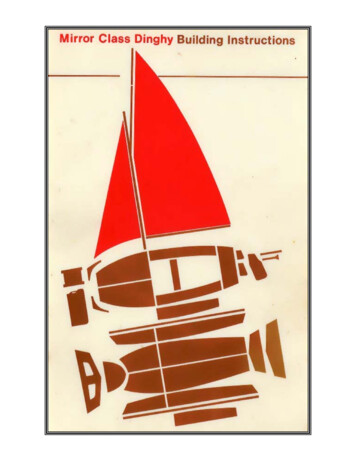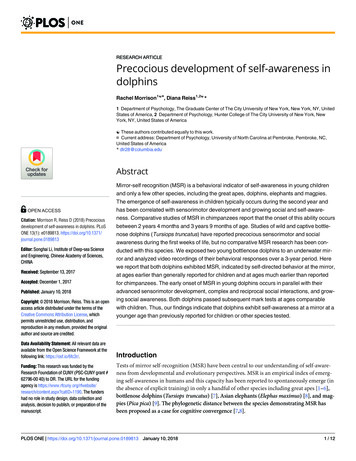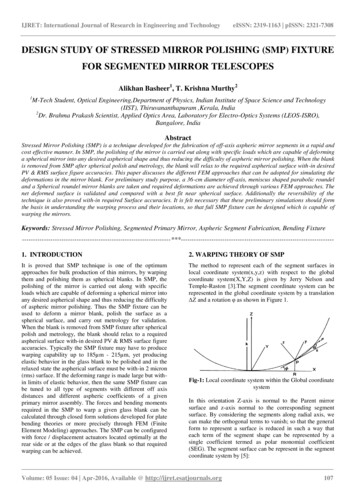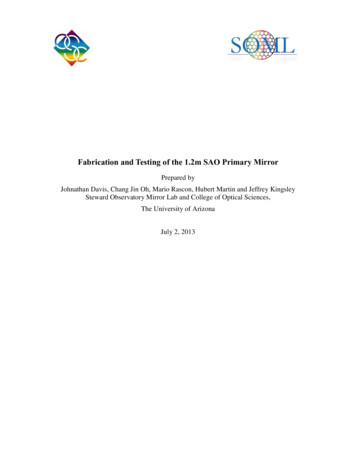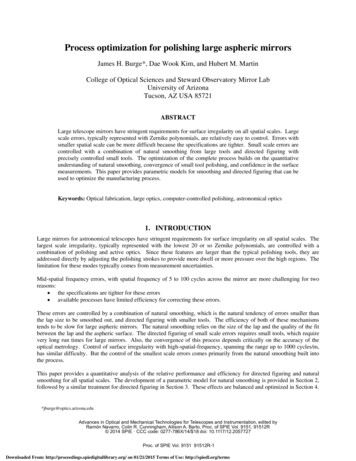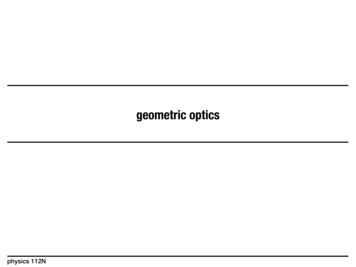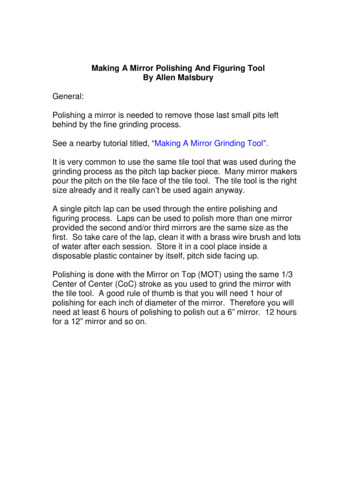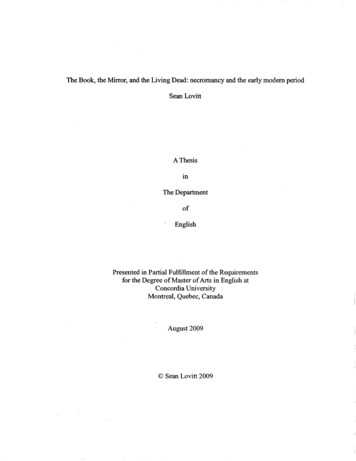
Transcription
The Book, the Mirror, and the Living Dead: necromancy and the early modern periodSean LovittA ThesisinThe DepartmentofEnglishPresented in Partial Fulfillment of the Requirementsfor the Degree of Master of Arts in English atConcordia UniversityMontreal, Quebec, CanadaAugust 2009 Sean Lovitt 2009
1*1Library and ArchivesCanadaBibliotheque etArchives CanadaPublished HeritageBranchDirection duPatrimoine de I'edition395 Wellington StreetOttawa ON K1A 0N4Canada395, rue WellingtonOttawa ON K1A0N4CanadaYourfileVotre referenceISBN: 978-0-494-63081-5Our file Notre referenceISBN: 978-0-494-63081-5NOTICE:AVIS:The author has granted a nonexclusive license allowing Library andArchives Canada to reproduce,publish, archive, preserve, conserve,communicate to the public bytelecommunication or on the Internet,loan, distribute and sell thesesworldwide, for commercial or noncommercial purposes, in microform,paper, electronic and/or any otherformats.L'auteur a accorde une licence non exclusivepermettant a la Bibliotheque et ArchivesCanada de reproduire, publier, archiver,sauvegarder, conserver, transmettre au publicpar telecommunication ou par I'lnternet, preter,distribuer et vendre des theses partout dans lemonde, a des fins commerciales ou autres, sursupport microforme, papier, electronique et/ouautres formats.The author retains copyrightownership and moral rights in thisthesis. Neither the thesis norsubstantial extracts from it may beprinted or otherwise reproducedwithout the author's permission.L'auteur conserve la propriety du droit d'auteuret des droits moraux qui protege cette these. Nila these ni des extraits substantiels de celle-cine doivent etre imprimes ou autrementreproduits sans son autorisation.In compliance with the CanadianPrivacy Act some supporting formsmay have been removedfromthisthesis.Conformement a la loi canadienne sur laprotection de la vie privee, queiquesformulaires secondaires ont ete enleves decette these.While these forms may be includedin the document page count, theirremoval does not represent any lossof content from the thesis.Bien que ces formulaires aient inclus dansla pagination, il n'y aura aucun contenumanquant. ICanada
iiiAbstractThe Book, the Mirror and the Living Dead:Necromancy and the Early Modern PeriodIn early modern England, necromancy was a general term applied to the practiceof black magic. Manuals for summoning demons, the dead, and other reprobateapparitions were available to the practitioners of this art, and descriptions of necromancyappeared in other genres ranging from theory to fiction. What the necromancer practicedin secret became a popular narrative made up of elements gleaned from the writings ofsupporters and detractors of magic. Orthodox Christians, Occultists, and skeptics alldenounced the activities of necromancers by publishing descriptive accounts. Thesedivergent bodies of literature inadvertently diffused a legend of the necromancer intopublic discourse. This thesis explores the curiosity and wonder that these narratives ofnecromancy provoked as they were staged in the theater. I examine ChristopherMarlowe's Doctor Faustus as the culmination of public concepts of necromancy and, inturn, I elucidate what this play has to say about the necromantic characteristics—specifically, taboo interests and excessive accumulation—of the surrounding culture.Likewise, I investigate the presence of necromancy in William Shakespeare's Hamlet inorder to analyze the fantastic characteristics of the Ghost and its influence on Hamlet'sactions in the play. The fantasy of necromancy—of delving into taboo subjects andbringing forth aberrant apparitions—materializes in drama, articulating curiosity andwonder as affects rather than as the technical instruments of epistemology.
IVAcknowledgementsI would like to thank the following people for helping me during this project: Dr.Meredith Evans for her constant advice and challenging suggestions that ultimatelyshaped this work; Dr. Kevin Pask and Dr. Danielle Bobker for making it through theoriginal version and offering thoughtful responses that will continue to influence myresearch; Danielle Lewis for her warm encouragement and diligent editing that preventedmy thesis from being one long sentence or a single polysyllabic word; liana Kronick forlistening to my woes for free; Bonnie-Jean Campbell for answering all my odd questions;as well as everyone who was amused by the idea that I was devoting a year to studyinghow to raise the dead. All of these people kept me motivated and grounded throughoutthe last year. Thank you again.
VTABLE OF CONTENTSIntroduction: The Cabinet: imagining necromantic manuals in John Dee's library11. The Book: representations of forbidden texts in Christopher Marlowe'sDoctor Faustus18Occult Subjects22The Tragicomedy of Faustus35A Pact with Hell452. The Mirror: looking at fear and wonder in Shakespeare's Hamlet66Riddles and Corpses67Fear and Wonder75The Perspective Glass84A Phantom Cell90Nothing is a Thing97An Enchanted CastleWorks Cited105112
1The Cabinet: imagining necromantic manuals in John Dee's libraryThey seek neither truth nor likelihood; they seek astonishment.They think metaphysics is a branch of the literature of fantasy (Borges xvi)raiw?KF/M.YvAwr / / Y *y ini-i'At/f,/ /A/- .far/'/MAGICIAN.'- -* / ,/ »t*vw' / *« ' / ./%v -v/.Figure 1. An engraving from Ebenezer Sibley's Illustration of the Occult Sciences (1784)'In an archetypal image of necromancy, two robed men stand in a magic circlefacing a reanimated body in a funeral shroud (Figure 1). In the early modern period,necromancy was a category that included a range of prohibited magical practices,This image is in the public domain and available online on various webpages. edward-kelly/edward-kelly-494x638.jpg
2epitomized by illicit attempts to resurrect the dead. Set in the gloom of night in a lonelychurchyard with the town barely visible in the background, this depiction of black magicimmediately summons up notions of forbidden and deeply secret activities. Thereanimated body is a grisly reminder of the taboo interests of magical practitioners. Oneman is decorated with various emblems that signify his role as a magician. In his lefthand, he holds a wand that points to the cryptic symbols and angelic names inscribed inthe circle. These symbols invoke the idea of magic in the viewer, in part, because they areunfamiliar. The ritual is symbolized by two other aspects of the image, both of which addto the aura of mystery. The first is the other man, who holds a torch in one hand andgesticulates with his other. His wide open mouth and theatrical posture suggest that he isperforming the ritual invocation or commanding the dead to speak. Curiously, the captionthat tells the viewer that what is depicted is an invocation of the dead, ascribes the act toEdward Kelley, "a" single magician.The orator, along with the words he speaks, remain obscure. The script for hisspeech is metonymically present in the form of a book, the second mystery, which is heldopen to be read in the first magician's hand. The pages face away from the viewer. Thebook is, in fact, almost entirely obscured by the shadows of this night scene. EdwardKelley's accessories—significantly, the book and the second man—illustrate how thetransmission of necromancy is dependent on embodying forbidden subjects in amysterious but illustrative form. The threat that black magic poses, the ability totransform a churchyard into fertile grounds for profane transgressions, becomes an imagefor contemplation. It is as a representation of necromancy that this image can be alignedwith the suspicious practices of others. Figuratively speaking, the ambiguous second man
3in the engraving can be stamped onto separate people as the stigma of necromancy. Thisstigma implied that the person in question had broke with natural and spiritual law and,by doing so, had achieved impossible feats. It is unclear whether the diffusion of this kindof imagery, along with accusations of necromancy, suppressed the appeal of diabolicaltransgressions or if it increased the public's fascination.This image is not simply an elucidation of necromantic practice but a complexmanifestation of the public's imagination. The second man in the picture is often thoughtto be an overtly public figure, John Dee. On the whole, Dee was not a stereotypicaloccultist, secluded and esoteric. He published books on mathematics and navigation, aswell as acquiring England's "largest and most valuable library and museum" (Shermanxiii). In John Dee: The Politics of Reading and Writing in the English Renaissance,William Sherman contends that Dee's contributed to the state as an adviser togovernmental, commercial, and scholarly networks (23). His reputation as a blackmagician began with an astrological consultation with Elizabeth I while she was still aprincess. Dee was arrested on the charge that he "endeavored by enchantements todestroy Queen Mary" (Clulee 33).2 The struggle to clear his name of charges of conjuringcontinued long after Mary's death. Sherman points out that Dee petitioned James I to helphim in this cause, which illustrates that Dee remained a public figure with some influencein court even though he was burdened by his own notoriety (19). The source of his publicinfluence is intimately connected to the origins of ignominious reputation. For Sherman,Dee's closest similarity to black magicians is his intellectual power, which provoked"anxiety, resentment, and violence" (51). The fact that "the first age of printing was also2Quoted in John Dee's Natural philosophy, Nicholas Clulee remarks that this charge was "substantiallycorrect" (33). However, he adds that the government informant also accused Dee of having a familiarspirit that had blinded the informant's children.
4an age of censorship and book burning" (Sherman 51) illuminates how Dee's social statuscould be met with different responses. The anxiety aroused by Dee's specializedknowledge was channeled into a legend reclassifying him as a necromancer.Gyorgy Szonyi locates the association of this image with Dee as a product ofseventeenth century popular imagination (287). Certainly, Dee's reputation as practitionerof black magic grew at this time, however, locating a source that associates him with thisimage proves difficult. Szonyi does not name a source that corroborates the allegationsthat Dee "raised the dead" (287). Of the wide array of magical practices that invokedunsanctified powers, the particular kind of black magic Dee was associated with in theseventeenth century was consorting with demons. Stories of Dee's forays into cemeteriesto raise the dead may be a much later invention3 that requires unpacking to understand.For a seventeenth century source of Dee's growing reputation, Szonyi offers MericCasaubon's publication of John Dee's transcription of angelic conversations in 1659.Casaubon prefaces his publication of these secret conversations by warning his readerthat Dee spoke to demons not angels (Szonyi 277). Casaubon's interest in sabotaging thisRenaissance scholar's reputation did not include an equal critique of Dee's associate in hisattempts to communicate with angels, Edward Kelley. Szonyi points out that Casaubon"did not deal in depth with the role of Kelley in the angelic conversations" (277), whichis strange since, as Nicholas Clulee reminds us, only Kelley is said to have seen andheard the angels (Clulee 204). It was the same Edward Kelley who is depicted in thisengraving who had mediated for John Dee, with a crystal ball, messages from angels.This magical practice, known as scrying, was the closest that Dee came to performing3A quick image search on Google for "John Dee" or "necromancy" will bring up this engraving withoutsources.
5black magic. One can assume that Kelley's spiritual mediation for Dee lead to Dee's laterassociation with demonic magic.Tracking the textual inspirations for these legends reveals more than a network ofmagical practitioners and practices. The example of Edward Kelley shows the urgeamong writers to invent and add new elements to infamous events. It was not just JohnDee who was willing to accept Kelley's magical powers and transcribe them. There is along tradition of writers who, even when their expressed intent is to depreciate magic,ascribe preternatural abilities to Kelley. The original publication of the story in whichKelley raised the dead appeared in John Weever's Ancient Funeral Monuments in 1631.Weever names Paul Waring as the source of the tale and as Kelley's magical accomplice(Waite xxvii). According to Weever, Paul Waring accompanied Edward Kelley to acemetery with the expressed intent of conjuring the dead. The nineteenth century magichistorian, Arthur Edward Waite, relates that when Ebenezer Sibley produced an illustratedversion of this story in the eighteenth century, he added details and a conclusion. Kelley'sresurrection of the dead is placed in a Faustian framework; Sibley ends his narrative byrecounting how some believe that Kelley made a pact with the devil and was later carriedoff to hell (Waite xxvii). The engraving of Kelley raising the dead first appears in thiscontext, which Waite calls a "tissue of falsehoods" (xxvii).Despite Waite's demystification, there is some basis for the speculation that Kelleyconversed with demons. In John Dee's diaries, Dee recounts that Kelley voiced an interestin contacting reprobate spirits (Clulee 212). Furthermore, Clulee points out that Kelleystructured the angelic conversations based on models from black magic (212). By placingmagical symbols underneath a crystal ball, the basis of Kelley's scrying ritual took on an
6appearance similar to the magic circle in the engraving. Sibley's image draws uponKelley's fascination with systems of demonic magic. It remained for Sibley to reinscribeKelley's interests with a popular form and setting. This fiction is radically reconfiguredwhen applied to John Dee. Since it was Dee who held the book while Kelley spoke tospirits the two figures in the image are inverted. Dee becomes the magician in theforeground, conducting the magic. Thus, the urge to fictionalize appropriates a centralfigure in early modern history. Suspect associations are converted into a narrative image.As an image, it can be separated from the subjects depicted to expand its diffusion. Theonly material artifact that could attest to the validity of these claims is Dee's writtenaccounts of magic. The magic book is a focal point of the image. It parallels the shroudedbody in that it thwarts its own promise for more information. This frustrated desire for aclearer picture of the event is embodied by the reiteration of obscurity in the image.The fact that Dee chose to transcribe the spiritual visions of Edward Kelley,knowing that he was interested in diabolical subjects, poses an interesting problem fortrying to separate necromancy from Dee's pursuits. Unlike atheism, as Stephen Greenblattdescribes it, black magic was not "thinkable only as the thought of another" (22). Theproliferation of instructional manuals for illicit magic demonstrates that black magic wasnot only a fascinating or threatening subject but also a genuine practice to which certainpeople subscribed. The notorious Johann Faust, the model for many literary depictions ofmagic, used his transgressive interests as an advertising technique, calling himself "theprince of necromancers" (Wenterdorf 201). Dee, however, did not subscribe tonecromancy, interpreting his own magical pursuits as a sacrosanct addition to hisestimable learning. Indeed, he ignored Kelley's own fears that the angels that they
7contacted together were wicked spirits deceiving them with descriptions lifted from otherbooks. When Kelley showed Dee a page in Cornelius Agrippa's Occult Philosophy thatprecisely repeated information that the angels had offered them, Dee argued that this wasevidence for Agrippa's credibility rather than the deception of evil spirits (Szonyi 278).This incident, recorded in Dee's diary, is a failed attempt by Dee to contain the illicitnature of Kelley's activities in a pious framework. His magical practice, and, byassociation his magical library, are framed within the interests of Edward Kelley.Although Dee remains the dominant voice in the stories that are written about him, thestories have their root in his desire for Kelley's oral narrations. Kelley's inventivedescriptions of conversations with spirits circumvent Dee's containment strategy,outliving the occultist's epistemology. Dee became entangled in the growing fiction of thenecromancer to which Kelley was, in part, a contributor.Investigations into Dee's diverse collections help complicate the picture of theearly modern magician. Sherman combats an argument that he deems "The Yates Thesis,"after the scholarship of Frances Yates who popularized an interpretation of Dee'soccultism that viewed his magical interests as the motivating factor in Renaissanceintellectual achievements (12). In place of an occult model, Sherman argues that Dee'svarious interests are encyclopedic in nature. Dee's "textual remains" generate competingportraits (Sherman 43) that cannot be synthesized into a single concept. Dee'sencyclopedic interest in a variety of subjects is understood in an architectural model.Rather than situating magic as an occult kernel to his studies, Dee's various interests arerepresented in his multifaceted Mortlake home. Sherman illustrates how Dee's library ispositioned in relation to his scientific instruments, laboratories, and the surrounding area.
8An urban dwelling with open areas of study for visiting scholars, Dee's home ischaracterized as a humanist museum (Sherman 21). The museum has a civic purpose,making available a wide range of subjects for investigation. Dee's private collections ofmaps, compasses, astronomical instruments, antiquarian documents, books, and "naturalwonders," (Sherman 34) played a crucial part in the education of the larger community.Opposed to an anachronistic private/public dichotomy, Sherman offers thecontemporaneous word "privy" to describe how Dee's house behaved like a membrane inorder to "let certain people, texts, and ideas in and kept others out" (49). This descriptionplaces Dee's magical interests on the shelves of an accessible library, amongst variousother modes of study.Dee's transcriptions of the angelic conversations, however, did not end up ondisplay in a museum until decades after his death. The story of their discovery shows howthe membrane of his library produced competing evaluations of his knowledge. Shermansays very little about Dee's hidden book. The angel diary appears in Sherman's narrativeamongst the various acquisitions of Dee's property. The first redistribution of theMortlake museum happened while Dee was still alive and in Prague. Dee returned hometo find that his museum had been "spoiled" (Sherman 52). The ambiguity of Dee's termhas lead to the recurring story that Dee's house was ransacked by angry townspeopletaking revenge on the conjuror in their midst. Of course, Sherman contests this story thatneatly fits into "the myth of the magus" (15). He argues instead that there is moreevidence that Dee's possessions were stolen by his former associates "envious of hispower" (52). This claim is accordance with the value assigned to his library andinstruments by later collectors. Upon Dee's death, his collections were reacquired and his
9land was bought by Robert Cotton who combed it for buried manuscripts (Sherman 30).Dee's possessions inspired avarice in his contemporaries more than they inspiredcondemnation. His magical learning was a part of a valuable collection of early modernparaphernalia.The book chronicling his magical endeavors has a history that varies from the restof his library. It was found hidden in a chest that had been acquired as furniture. Thisbook does not easily fit into the public face of his collection that Sherman describes. Itsvalue was not even recognized by its new owner who allowed his maid to use it as wastepaper (Sherman 31). Its contents describe the use of reflective surfaces to invoke spirits,and, as such, belongs among his collection of curiosities. The value of this book is that itrecords the use of his "famous crystal ball" and his "collection of mirrors" that "includedan obsidian disk of Spanish-American origin used for communication with angels, andseveral used for optical experiments and illusions" (Sherman 34). Sherman writes thatthis collection was used as well in order "to amuse the queen" (34). It is through opticalillusions performed for the aristocracy that Dee's magical experiments begin to derive apublic face. His ability to produce wonders compounded his reputation as a conjurer.Barbara Traister, in Heavenly Necromancers, points out that Dee's arrest for astrologycoincided with his creation of a stage prop that appeared to be a flying beetle (18). Thegrowing suspicion of Dee's conjuring was directly related to the public's interest in seeingmarvels performed. Dee participated in this trend by hiring Kelley to take the power ofthese devices to another level. Kelley's ability to see angels by staring into a mirror is asupernatural extension of the natural wonders that were popular additions to cabinets ofcuriosity. Dee's magical diaries are a transcription of these performances that take
10wonders into the realm of fantasy.According to Steven Mullaney the cabinet of curiosity is emblematic of the earlymodern cultural current that sought to dramatize cultural productions (65). In The Placeof the Stage, he describes a typical English cabinet belonging to Walter Cope. Thecatalogue of his collection contains such disparate objects as "[a]n Indian stone axe, 'likea thunderbolt,' A stringed instrument with but one string. The twisted horn of a bull seal.An embalmed child or Mumia. The bauble and bells of Henry VIII's fool. A unicorn's tail. . . " (60). What Mullaney lists in his work is extensive but inevitably incomplete. Whathis cross section of the various objects reveals is that there is no defining boundary forthis type of collection. Rather, the cabinet of curiosity is "characterized primarily by itsencyclopedic appetite for the marvellous or the strange" (60-61). What accounts for this"heteroclite order" of things is the dramatic presentation of culture as estranged andothered. The combination of familiar and unfamiliar displays culture as something toperform rather than understand. What Mullaney calls a "rehearsal of cultures" applies toJohn Dee's supplication to the queen in his treatise entitled The Compendius Rehearsal.Part of the function of this treatise was to clear Dee's name of the stigma of conjurer(Mullaney 70). Mullaney reads this rehearsal as part of the "larger dramaturgy of powerand its confrontations with the forbidden or the taboo" (70). By performing identities, theforbidden and othered qualities are safely incorporated into a dramaturgical culture. "Thecultural license" offered by these performances is compared to the theatrical stage, which"was also . . . a strange thing in and of itself' (Mullaney 75). Mullaney argues that thechange that transformed the "rehearsals" of wonder-cabinets into the space of scientificinquiry is discontinuous from their original purpose. He argues that:
11[t]he museum as an institution rises from the ruins of such collections, likecountry houses built from dismantled stonework of dissolved monasteries; itorganizes the wonder-cabinet by breaking it down—that is to say, by analysing it,regrouping the random and the strange into recognizable categories that aresystematic, discrete, and exemplary (60-61).If there is any continuity it is that the dramatizing of threateningly strange things operatedto domesticate them, readying the display of culture for this next development. Thisdomestication is invariably incomplete. Despite Dee's declaration of scholasticism andrepudiation of conjuring, he is remembered for his curious involvement in magic.It is not my concern to dispel the reader's interest in magic. In fact, it is one of theaims of my argument to rehabilitate this fiction of the necromancer. Although Dee neverconjured any dead bodies from the grave, the motivation for constructing that storyillustrates an element of our fascination that is worth exploring. To compare these storiesof necromancy to the products of cabinets of curiosity is to admire an aspect of them thatis often debased. Philip Fisher, writing on the scientific value of wonder, criticizes magicand cabinets simultaneously. He contends:[i]t was on the grave of magic tricks, religious miracles, and, especially, 'Wondercabinets'—those museums of prescientific confusion about wonder where twoheaded calves, bleeding crucifixes, and scientifically interesting stones andmagnets were jumbled together—that the new concept of Cartesian wonder was
12erected. (47)What he calls prescientific contusion is the product of an early modern epistemology.Christopher Pye explains that the marvels in a cabinet were:constituted within the vast web of similitudes or correspondences that make upthe universe. If the small space of the cabinet can be seen to approximate or evenconjure the world, that is because the world is constituted in terms of exactly suchmetaphorical correspondances between microcosm and macrocosm, man andworld, mundane and divine. (131).Yet, there is more to the collecting of cabinets of curiosity than the reproduction of theknown world or cosmos. Pye modifies this description by asserting that "[s]uch accountsof the wonder cabinets explains everything about them except their most salient feature:their preoccupation with precisely what is singular, odd, and unclassifiable, with 'therarity'" (131). For Pye, the rarity "represents something in addition, a supplement toknowledge" (133). It is this supplement—threatening to transgress the normative andenter the taboo—that ties together the necromancer and the curiosity.The collector and the necromancer both are concerned with displaying qualitiesthat extend beyond the domesticated. In both cases, their boundary breaking is realized asa performance within these boundaries. The display of obscure animals works best whenposed within the home. Equally, the impossible and frightening exploits of thenecromancer are only legible in the cultural productions that represent them for a mass
13audience. However, this adaptation does not necessarily imply that the impact of thesedisplays are congruent with cultural decorum. In fact, in the case of collectors, theattempts to establish an appropriately rational and scientific basis for collections wereoften overwhelmed by the competing tradition that valued objects for their ability toproduce awe. In "The Cabinet Institutionalized," Michael Hunter explores the genesis ofthe modern museum and discovers that even after the curators established theircategorical rationale for their collections, donors still used "the criteria of rarity andcuriosity" for discerning the appropriate form for gifts (165). The theatrical display ofthese curiosities has a semiotic similarity to how necromancers were imagined to displaytheir spiritual manifestations. In Imperato's illustration of his cabinet, the collector directsattention to the strangely lifelike animals with a long staff (Figure 2). The performance ofthis display of the dead is eerily similar to the image of Kelley with his wand, strangesymbols, and dead body. Walter Benjamin describes the performance of collection insimilar magical terms:The most profound enchantment for the collector is the locking of individualitems within a magic circle in which they are fixed as the final thrill, the thrill ofacquisition, passes over them . . . for a true collector the whole background of anitem adds up to a magic encyclopedia whose quintessence is the fate of his object("Unpacking" 59)
14Figure 2. Woodcut from Imperato's Dell'Histoire naturelle.(Reprinted in Cabinets of Curiosity 12)Magic, in this case, is the capacity for addition, for producing the apparition of strangeobjects within the familiar environment. While this process is easily understood ascultural appropriation, there is also an element of cultural production. A dramaturgicalfiction develops through these performances, which exists in excess of rationalexplanation, in response to the public's fascination.The fascination with rarity, especially the terrifying or shocking anomaly remainsin Western culture. In Pye's account the rarity is an agent for the "limitless desire forsomething more" (133). "[T]wo headed calves [and] bleeding crucifixes" (Fisher 47)
15belong to the sphere of fantasy as much as science. Fisher's fear that the astonishmentprovoked by this limitlessness is the first step toward "a total surrender to religiousdiscipline" (Fisher 54) ignores the other outgrowths of these fantasies. It is equallypossible that the religious treatises against unrestrained curiosity spawned an interest intheir most salient protagonists, the necromancer. Likewise, secular mediums are inclinedto produce seemingly inexplicable wonders for the sake of entertainment. Moreover, thedramaturgical impulse to recreate cultures and nature in performative scenes is alive andwell in the dioramas of modern museums. These reanimations of the dead are practicallynecromantic, invoking curiosity and wonder through dramaturgy. This thesis will explorethe impulse to add to the dramaturgy of necromancy where it converges with thecharacteristics of cabinets of curiosity. I will employ plays that were contemporaneouswith this mode of collecting to analyze how the elements of curiosity and wonder work inthese dramatic counterparts. While I intend to rehabilitate the study of necromancy as alegitima
The Book, the Mirror and the Living Dead: Necromancy and the Early Modern Period In early modern England, necromancy was a general term applied to the practice of black magic. Manuals for summoning demons, the dead, and other reprobate apparitions were available to the
